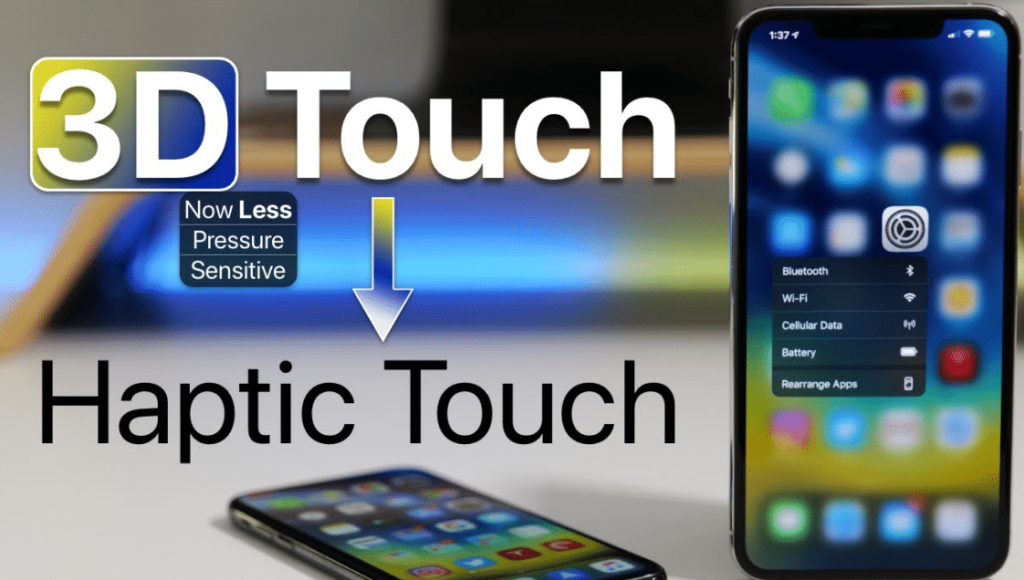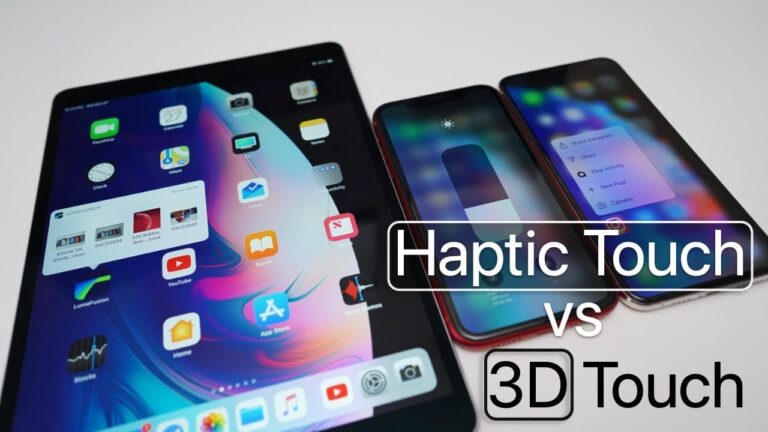With the iPhone 11, 11 Pro, 11 Pro Max, and 2020 iPhone SE, Apple got rid of 3D Touch across its whole iPhone arrangement, supplanting the previous ‌3D Touch‌ feature with Haptic Touch.
In this guide, we’ll go over all you require to think about Haptic Touch and difference between 3D and Haptic Touch.
What we will see here?
What is Haptic Touch?

Apple presented a pressing factor-sensitive innovation in 2015 called 3D Touch. However, in 2018 this technology becomes undesirable, and the iPhone XR, iPhone SE, iPhone 11 models and iPhone 12 models supplanted it with Haptic Touch.
It utilizes the Taptic Engine and gives haptic feedback when the screen is pushed on one of Apple’s new iPhones. It is a touch-and-hold gesture, and it very well may be utilized across the iOS 13 working framework.
Haptic Touch can be utilized by squeezing in a significant location until somewhat haptic pop is felt against the finger and a secondary menu springs up, with content changing depending on where you’re utilizing the feature. A basic tap will enact one of the choices on the secondary menu that springs up.
Difference between Haptic and 3D Touch
3D Touch-empowered gadgets from the iPhone 6S onwards enable you to apply pressure to the screen. Also, you can get a shortcut menu, particularly on app images.
This also permitted you to push on your iPhone’s screen all the more immovably to perform various activities. For instance, you could 3D Touch an app icon on your Home screen to open easy routes for it, or 3D Touch a connection in the Messages app to preview it without opening it completely.
Apple’s Haptic Touch technology is like 3D Touch yet it doesn’t depend on pressure.
Taking everything into account, Haptic Touch is enabled when a user long-presses the screen, offering a little vibration as insistence.
Haptic Touch offers basically the same of an encounter as 3D Touch, without requiring the extra hardware and pressure sensitivity that 3D touch required.
Be that as it may, Haptic touch is not pressure-sensitive like 3D Touch was. Instead, subsequent to holding your finger on a component briefly, you’ll feel a speedy vibration and the alternative activity will occur.
For instance, Apple utilized the multiple pressure levels for “Peek and Pop” gestures.
On a ‌3D Touch‌ device, you had the option “Peek” into a web connect to see a preview, and then press harder to pop into it and open it up in Safari, for instance.
Those auxiliary “pop” gestures are not available with Haptic Touch since it’s the alone degree of pressing factor (essentially a long press) rather than different pressing factor levels.
Haptic Touch is software-based instead of hardware-based, while 3D Touch was hardware-based, requiring an alternate sort of screen technology that would have made it hard to convey the edge-to-edge displays we presently anticipate.
There are some outstanding contrasts in how Haptic Touch and ‌3D Touch‌ carry on. For instance, with ‌3D Touch‌, you could press any place on the keyboard to transform the iOS keyboard into a cursor. With Haptic Touch, you need to utilize that gesture on the space bar, which is an adjustment.
Deleting apps has likewise changed fairly. Maybe then pressing and holding momentarily to make the apps “jiggle,” a press and hold currently raises a choice to “Rearrange” apps, which leaves them alone rearranged or deleted. You can in any case utilize the old strategy, yet the press and hold should be much more.
Where does Haptic Touch work?

It works wherever that ‌3D Touch‌ works. You can utilize it :
- On the Home screen app symbols to raise Quick Actions.
- On joins, telephone numbers, locations, and more.
- To review content or to enact various gestures on the ‌iPhone‌ or to raise different contextual menus.
- Seeing conversations in the Messages app.
- Showing more alternatives for toggles in Control Center.
- Enacting a Live Photo
- Utilizing the flashlight and camera shortcuts. This is found on the Lock screen
- Getting to shortcuts for apps on your Home screen
- Seeing website links in Safari or other apps
With Haptic Touch, when you long-press some apps, the shortcut menu will show up, alongside the alternative to Remove App or Edit Home Screen. For other apps that haven’t created Haptic Touch similarity at this point, just the choice to Remove App, Share App or Edit Home Screen will show up.
At the point when 3D Touch initially dispatched, a couple apps were compatible – transcendently Apple’s local apps. As the months and years went on in any case, more third-party apps worked in similarity and keeping in mind that 3D Touch was never a feature we utilized that much, there were some lovely cool shortcuts.
As per Apple, Haptic Touch “allows you to do things quicker, similar to take selfies without dispatching the camera app”. It currently offers a great deal of functionalities very much like 3D Touch – you are probably not going to miss 3D Touch by any means (in the event that you utilized it in any case).
Which applications work with Haptic Touch?
A large portion of Apple’s local applications work with Haptic Touch – however not all – and there are a couple of third-party applications as well. Here’s a rundown of a couple of our #1 icons to long-press on to convey shortcuts:
- Torch – This is found at the base of your lock screen. Used for turning on or off.
- Notification -This is found on the lock screen for viewing details.
- Camera app to see a menu for taking a selfie, record a video, take a portrait, or take a portrait selfie
- Calendar app to add an event quickly
- Photos app to see your latest photographs, your favorites, search or show photographs from one year prior
- Phone app to make another contact, search for a contact, see your latest call, see your latest voicemail.
- Maps app to send your location, mark your location or search close by.
- Fitness app to see patterns, exercises, sharing, and the choice to send your activity rings.
- Settings app to open Bluetooth, Wi-Fi, Mobile Data, and Battery settings.
- Mail app to open all inboxes, make another email, search messages, or see VIP messages.
- Safari show your bookmarks, start another private tab, start another tab or show your reading list.
Some more !
- Clock to make an alarm, start a stopwatch, or start a timer.
- Siri Shortcuts to see your shortcuts or make another shortcut.
- Weather app to see the climate in your location, add a location, or see other late locations.
- Health app to see your Medical ID, a synopsis, or all your wellbeing information.
- WhatsApp to begin another chat, search chats, open the camera, or see your starred messages.
- Slack to rest notifications or search your DMs and channels.
- Instagram to open the camera, make another post, see activity or see direct messages.
- Sonos to continue your last played, search or see My Sonos.
- Waze to commute home, drive to work, send your location, or search a location.
-
Amazon to open search, view today’s deals, or for scanning a product. - ASOS to see new in, saved things or open search
Does Haptic Touch feel unique?
It feels unique, generally on the grounds that it works a piece more slow than ‌3D Touch‌ signals. It is a press and hold sensation, while ‌3D Touch‌ is a quicker press with power sort of motion that actuates faster.
The real haptic feedback segment of Haptic Touch feels like the feedback got from a ‌3D Touch‌, so in that regard, it’s near undefined. As referenced, however, there’s no secondary level of feedback when utilizing Haptic Touch like there was with ‌3D Touch‌.
Change the sensitivity of Haptic Touch
There are two sensitivity options for Touch – fast or slow. Fast will deliver shortcut menus quicker so you don’t have to press an icon for as long.
To change the sensitivity :
- Open up the Settings app.
- Choose the Accessibility section.
- Tap on “Touch.”
- Tap on “Haptic Touch
- Select Fast or Slow.

There’s an option to preview the Haptic Touch feedback options right in the Settings app. Most people are likely going to want to keep the Haptic Touch feedback set to Fast because even Fast is on the slow side compared to ‌3D Touch‌.
For what reason did Apple dispose of 3D Touch?

‌3D Touch‌ was never accessible on the iPad, so Apple may have nixed it to ensure the ‌iPhone‌ and the ‌iPad‌ offer a similar experience.
With Haptic Touch and a long press on the ‌iPad‌, the gestures used to get to extra logical data like Quick Actions are something similar. That was never the situation with ‌3D Touch‌ – the ‌iPad‌ just didn’t have the additional gestures accessible.
‌3D Touch‌ was likewise something of a periphery feature that was never standard, which could likewise be a motivation behind why Apple chose to go with something that is more straightforward and eventually more instinctive. One single press gesture is simpler to use than a press motion that upholds various levels of pressure for various actions.
Will 3D Touch return?
Since ‌3D Touch‌ has been disposed of across Apple’s ‌iPhone‌ arrangement and ‌3D Touch‌ gestures have been changed to be more Haptic Touch friendly even on more seasoned iPhones, Haptic Touch is by all accounts the new norm and standard. We can anticipate that Haptic Touch should be the new feedback feature in iPhones going ahead. And conclusively, it’s not likely ‌3D Touch‌ will make a return.
Finishing Off!
In many ways, Haptic Touch is similar to 3D Touch, but it’s not quite the same. The difference between Haptic Touch and 3D Touch is essentially based on the force of the touch. While the latter is more of a pressure-sensitive pop, Haptic Touch is a long press paired with an electric feedback when you press.
Additionally, on 3D Touch, iPhone users got numerous levels of responsiveness because of the pressure sensitivity, which you won’t see with the Haptic Touch feature.
While new iPhone users will not discover anything missing from the gadget, normal iPhone users may miss the feature somewhat because of the dynamic responsiveness 3D Touch offered.
















